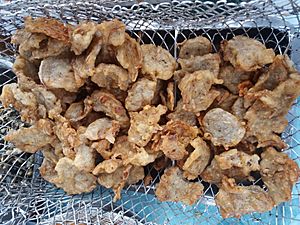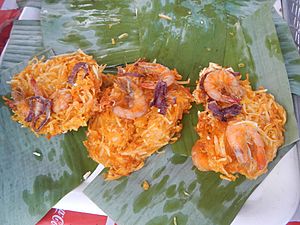Okoy facts for kids

Shrimp okoy from Vigan, Ilocos Sur
|
|
| Alternative names | Ukoy |
|---|---|
| Course | Main course, side dish |
| Place of origin | Philippines |
| Serving temperature | Warm |
| Similar dishes | Camaron rebosado, calamares, bazun khwet kyaw, Bakwan |
Okoy (also called ukoy) is a yummy Filipino snack. It is a crispy, deep-fried fritter. It's made with a special batter from glutinous rice.
Inside, you'll find small shrimp that still have their shells. It also has lots of vegetables. These can include calabaza (a type of squash), sweet potato, cassava, and mung bean sprouts. You might also find scallions, julienned carrots, onions, and green papaya.
People usually eat okoy with a vinegar-based dipping sauce. You can enjoy it by itself or with white rice. It's a popular choice for breakfast, a quick snack, or as an appetizer before a meal. Sometimes, okoy is made bright orange using seeds from the achuete plant.
There are many ways to make okoy. You can swap the shrimp for small fish or calamari. The batter can also be made with regular flour, rice flour, or a mix of egg and cornstarch. Sometimes, okoy can even mean omelettes made with mashed calabaza or sweet potato, with or without shrimp.
Contents
What's in a Name? The Story of Okoy
A Filipino expert in languages, Gloria Chan-Yap, studied the name okoy. She thinks it comes from the Hokkien words ō+kuè. These words mean "cake made from taro".
However, the Hokkien dish and okoy are quite different. The Hokkien dish is deep-fried taro with minced pork. Okoy doesn't use taro or pork. The only things they have in common are being deep-fried and shaped like a pancake.
How Okoy is Made
The most traditional way to make okoy starts with a small amount of galapong. This is ground glutinous rice that has been soaked in water. This makes the batter.
The batter is seasoned with onion, garlic, salt, and scallions. Then, mashed kalabasa (calabaza) and small, unshelled shrimp are mixed in. The mixture is deep-fried as small, flat patties until they turn golden brown. After cooking, any extra oil is drained. Okoy is best served warm and crispy.
Instead of calabaza, or in addition to it, the batter can be mixed with kamote (sweet potato) or kamoteng kahoy (cassava). Other common additions include mung bean sprouts (called togue). You can also add julienned carrots, onions, and green papaya. Sometimes, achuete seeds are used to give the dish a bright orange color.
Okoy can be a meal on its own or eaten with white rice. It's often enjoyed as a snack, an appetizer, or for breakfast.
Dipping Sauces for Okoy
Traditionally, okoy is served with a vinegar-based dipping sauce. Two popular ones are sinamak and pinakurat.
- Sinamak is a vinegar mixed with labuyo chilis, ginger, garlic, peppercorns, and onion.
- Pinakurat is vinegar with fish sauce, labuyo chilis, peppercorns, ginger, garlic, and dried mangoes.
But you can also dip okoy in other sauces. These include banana ketchup, tomato ketchup, sweet and sour sauces, or even garlic mayonnaise.
Different Kinds of Okoy

Today, many okoy recipes use regular flour or rice flour instead of galapong. Sometimes, a mix of egg and cornstarch is used for the batter. The word okoy can also refer to savory omelettes made with mashed calabaza or sweet potato. These are more accurately called tortang kalabasa or tortang kamote.
Sometimes, the shrimp are left out completely. This is common when using mashed calabaza or sweet potato. Instead of shrimp, you can use small fish like dilis (anchovies) or dulong (noodlefish). Calamari or even shredded chicken can also be used. If you use larger shrimp, they can be shelled and cooked tempura-style.
Okoy can be changed easily to include other ingredients. These might be potatoes, bell peppers, peppercorns, tokwa (tofu), grated coconut, and apulid (water chestnuts). A special kind of okoy uses banana flowers, which are called puso ng saging (meaning "banana heart"). These are cooked in the batter.
A dish similar to okoy is tortang dulong or maranay. This is an omelette made from very tiny fish from the Salangidae family. These fish are known as dulong in Tagalog and ipon, libgao, or maranay in Visayan.
See also
 In Spanish: Okoy para niños
In Spanish: Okoy para niños


